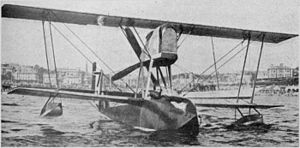SIAI S.13
| SIAI S.13 | |
|---|---|

| |
| Role | Reconnaissance-fighter flying-boat |
| National origin | Italy |
| Manufacturer | SIAI |
| Primary user | Regia Marina |



The SIAI S.13 was an Italian 1910s reconnaissance flying-boat.
Design and development
Designed by the Società Idrovolanti Alta Italia (SIAI) as a smaller version of the earlier S.12, the S.13 was a single-engined biplane reconnaissance-fighter flying boat. It had a crew of two in side-by-side seats behind a single windscreen; the observer had a single trainably[check spelling]-mounted machine-gun. The flying boat was powered by a single 250 hp (187 kW) Isotta Fraschini V6 engine.
Emile Taddéoli, a Swiss flight pioneer and later chief pilot of the Ad Astra Aero, left Switzerland for Sesto Calende where he was hired as test pilot for Savoia in mid-1914. During the next five years of activity, Taddéoli made more than 2,700 flight tests, flying about 150,000 kilometres (93,000 mi). In January 1919 Emile Taddéoli was pioneering again in crossing the Apennine Mountains in a seaplane between Sesto Calende and San Remo. On 12 July 1919, with a passenger on board, he flew from Calende on Lago Maggiore to Lake Geneva in 110 minutes, overflying the Mont Blanc (4,695 metres (15,404 ft)) massif in his SIAI S.13.
The Royal Italian Navy took delivery of 12 aircraft in 1919, and the flying boat was exported to Japan, Norway, Spain, Sweden, and Yugoslavia. In France, the S.13 was built under license as the CAMS C.13 and the Spanish naval workshops in Barcelona also built seven under licence.
A single-seat version, the S.13 Tipo, was ordered by the Royal Italian Navy, but was later cancelled when the Royal Navy decided to develop the Macchi M.7 instead and a civilian version, the S.13bis, failed to attract any orders.
Variants
- S.13
- Production flying boat
- S.13 Tipo
- Single-seat variant, not built.
- S.13bis
- Civil variant, not built.
- CAMS C-13
- French licence-built S.13
Operators
 France (as CAMS C-13)
France (as CAMS C-13)
- Swedish Navy (Marinens Flygväsen)
Specifications (S13)
General characteristics
- Crew: two (pilot, observer)
Performance
See also
Related lists
References
- Taylor, Michael J. H. (1989). Jane's Encyclopedia of Aviation. London: Studio Editions.
- The Illustrated Encyclopedia of Aircraft (Part Work 1982–1985). Orbis Publishing.
{{cite book}}: Cite has empty unknown parameter:|coauthors=(help) - Hirschauer, Louis; Dollfus, Charles, eds. (1920). L'Année Aéronautique: 1919-1920. Paris: Dunod. p. 15. (also page 47)
